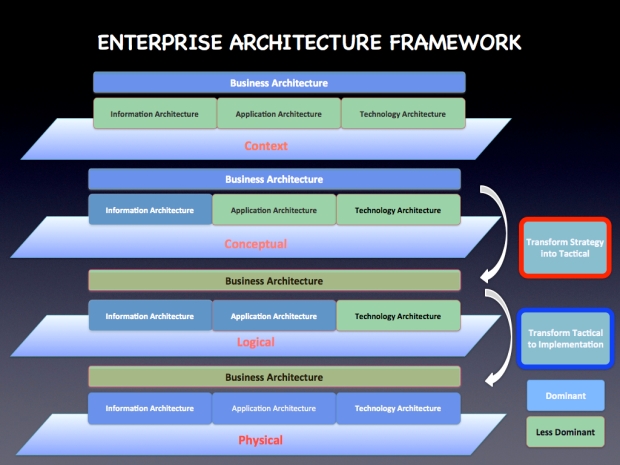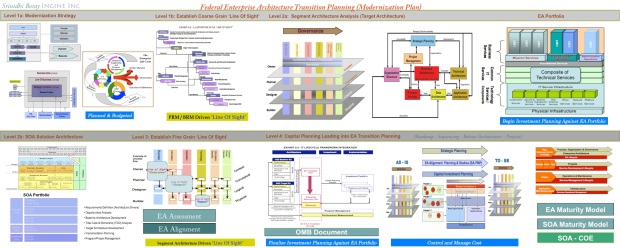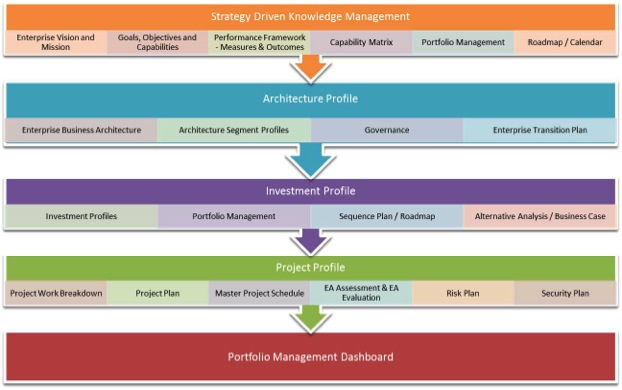_(4528252054).jpg) Thinker Practitioner
Thinker Practitioner
While thinking of ideas discussed in this blog, have been probing the tenants that creates the fundamental characteristics of the system such as :-
- Division Of Labor – the most important idea that revolutionized industrialization and for rise of capitalism
- Commodiitization vs Specialization
- Production of cost by Economy Of Scale by Division vs Multiplexing (manual vs automation)
- Holistic vs Reductionist
- Organic vs Inorganic (natural dichotomy)
- Autonomy (increased self sufficiency) vs Corporate Sovereignty
- Natural Selection leading into Adaptive vs Self Regulation leading into Generative
- Centralization vs Polycentrism; and Federation
- Simplicity vs Complicated (not to be confused with Complex System)
The above premise must be used as background in probing the discipline EA – which is essentially a System Theory being an integrative of several disciplines such as sociology, economics, business management, information technology etc
Defeating Cognitive Bias and Instant Gratification
Basically have been battling within my head why this discipline Enterprise Architecture went so whacky in the corridors of corporates. I think all the below discussed stuff are symptoms. The core reasons I think is basically in the deviant behavior that corporate culture tends to promote driven by short term gains. Lets call this deviant theory (Corporate) Anomie a concept developed by Emile Durkheim, a French sociologist, who introduced this concept of Anomie in his book The Division of Labor in Society, published in 1893. Later expanded in the book Suicide published in 1897. Emile Durkheim is considered as the “father of sociology”.
1. Not for those Not solving Systemic Concerns
https://ingine.wordpress.com/2007/08/22/enterprise-architecture-economic-model-system-dynamics/
Enterprise Architecture (EA) as a discipline is engaged to solve problems within systemic context. Where the (a) challenge of realizing business strategy by enabling relevant business capabilities (b) delivered by set of tactical objectives (operational) achieved by (c) making informed and decisive investments in technologies. When such systemic concerns are not being addressed, then EA is overkill. EA while it strives to solve macro concerns it does so by aligning well designed several sets of micro objectives.
2. Not for those who lack appreciation for Order and Maturity
Generally, EA as a discipline is better desired when an enterprise strives to scale order of maturity to manage complexity by rational means. To develop organizational skills, a decisive competencies framework is desired.
https://ingine.wordpress.com/2010/03/17/enterprise-architecture-maturity-model-framework-federal/
Developing Enterprise Architecture Practitioner Competencies
3. Not for those who cannot deal with Abstraction
EA is not for those who have not trained their mind to think in abstraction. Especially those who find themselves comfortable in dealing with physicality and forms will require head wrenching exercise to hone mind to develop abilities to deal with varieties of abstractions, while representing them with varying semantics that help in delineation, thus leading into layered representation in terms of a framework.
“Separation of Concerns” is one such technique that achieve delineation by introduction of semantics and eventually it also helps in the design of EA Framework.
https://ingine.wordpress.com/2007/08/17/christopher-alexander-father-of-pattern-language/
EA is not for those, who in abstraction find it difficult to delineate contextual from conceptual; and conceptual from logical and logical from physical.
4. Not for Reductionist; instead suited for Holistic Thinkers
https://ingine.wordpress.com/2007/08/08/the-black-swan/
EA is not for those who are only reductionists in approach and who think everything in the world can be reduced to simple set of objects or objectives. EA is not necessarily Cartesian and certainly not for linear thinkers. EA is not about immediately discovering implementation; in fact it is delayed gratification by introducing decisive rationalizing process before subjective strategy turn into executable objective actions yielding the best business results by leverage.
5. Not for those who pursue Transformation without Goals
Although EA might help manage both organic and inorganic growth of an organization; by itself it is a disciple dealing with inconsistencies owing to structure and mechanism found within and their impact on transformation augmenting enterprise growth
Enterprises in Generative Transformation (akin to Universe Life-cycle)
6. Not for those who pursue merely Functional Goals and NOT be concerned with Ecosystem’s Harmony
Huichol’s Shamanic Vision – Mandala (Architecture) of the Consciousness – No History of War
EA is not a mere IT role, especially a difficult role for those who have worked only in the areas of IT infra and in delivering such services. EA is not limited only to physical layer.
EA is not for those who find it difficult to distinguish business strategy from business architecture; business architecture from application architecture; application architecture from technology (infra) architecture. And, importantly EA is an overarching and all encompassing meta-architecture inclusive of all those levels of architecture that holistically represents an enterprise in relevant abstractions.
Architecture is a holistic sum striving to achieve systemic balance by aligning function, performance and cost
Math and statistical although important, those approaches alone are not adequate to envision future capabilities for an organization. Likewise advents in technology alone do not necessarily prove transformative. Knowledge of IT architecture by itself is not transformative. Instead, EA as a discipline requires to integrate Architecture, Capital Planning and Program Portfolio Management. All these brought together by productive Governance; even then the challenges of future remains fleeting.
7. Not for those who think Taxonomy suffices to represent EA and NOT Ontology
There is distinct semantics used to represent each of the layers (“separation of concerns”). Semantics introduces dimensionality to the architecture layers and they cannot be represented with limited set of semantics in limited dimensions. Each layer that is semantically different from the other requires transformation in planning and design to discover the opportunities in each layer. Ontology plays an important role in developing and assimilating ideas leading into discovering creative transformative opportunities. EA is not for those who tend to reduce everything into simple 2D representations in the hope that simplified versions help manage complexity better.
8. Not for those who are Programmatic in Approach and Not Practitioners
Not for those who do not understand what disposes them to be credible management consultants. Furthermore, also not for those management consultants who have not gained appreciation for structure, semantics driven architecture and mechanism within; and their role together in systemic transformation, functional modernization and economic optimization.
Consultants are those who have gained immense multi-lateral experience in the industry in variety of areas especially in conducting transformation, modernization and optimization related activities. Generally individual gains such experiences driven by motivation to solve large fleeting problems those are systemic in nature. Not by pursuing opportunities where sole motivation is revenue generation no matter what.
Practitioners develop insight by assiduously probing the problem and complexity. The skills do not develop overnight. It is not swashbuckling nor shooting through the hip. It is developing opportunity by being proactive and intense probing.
There are no Outliers (myth destroyed by Malcolm Gladwell http://en.wikipedia.org/wiki/Outliers_(book) )
“””A common theme that appears throughout Outliers is the “10,000-Hour Rule”, based on a study by Anders Ericsson. Gladwell claims that greatness requires enormous time, using the source of The Beatles’ musical talents and Gates’ computer savvy as examples.[3] The Beatles performed live in Hamburg, Germany over 1,200 times from 1960 to 1964, amassing more than 10,000 hours of playing time, therefore meeting the 10,000-Hour Rule. Gladwell asserts that all of the time The Beatles spent performing shaped their talent, and quotes Beatles’ biographer Philip Norman as saying, “So by the time they returned to England from Hamburg, Germany, ‘they sounded like no one else. It was the making of them.'”[3]Gates met the 10,000-Hour Rule when he gained access to a high school computer in 1968 at the age of 13, and spent 10,000 hours programming on it.[3]“””
9. Not for those who provide professional expertise as Contractor and NOT as Practitioner
http://www.ipthree.org/frontpage-features/94-messageprofessionals
http://www.cos-mag.com/human-resources/hr-columns/whats-in-a-name-professional-vs-practitioner.html
It is not a contracting role – In theory contracting assumes that the client understand the requirement and they control the way project gets executed. This is obviously flawed approach.
Generally those who have thrived only in delivering IT services of operational nature are not the candidates for conducting management consulting, since most of their career has been delivering IT solutions and services for a requirement determined by the client and their consultants.
10. Not for those who do not value Professional Integrity
https://ingine.wordpress.com/2007/08/09/enterprise-architect-fighting-obfuscation/
Importantly EA is a Practitioner Discipline introducing high standards emphasizing on quality in rendering and most importantly professional ethics promoting the desired ethos for organization’s evident growth and maturity. The results of EA achieves transparency, accountability and line of sight driven by “structuralism” striving to achieve “order”.
11. Not for those who build career around Tools and NOT around Discipline Integrating Science and Art
EA is not a discipline that can be developed by building career around tools. Tools by themselves do not create Art and neither advances Science. EA is integrative of architecture, capital planning and program management. All these driven by corporate governance.
https://ingine.wordpress.com/2008/12/01/creative-people-at-work/
https://ingine.wordpress.com/2008/11/23/in-lack-of-theory-planning-will-be-along-a-straight-line/
12.Not for those who engage merely in IT Operation and Implementation
EA is integrative of strategy, operations and implementation
13. Not for those who DO NOT Develop Enterprise Transition Plan and Operating Model (must skill for EA)
https://ingine.wordpress.com/2010/04/12/etp/
Enterprise Architecture Framework for Transition Planning (Line of Sight based)
14. Not for those who think EA and Solution Architecture are synonymous
http://weblog.tetradian.com/2012/09/13/linking-ea-with-sa/
15. Not for those obsessed with Dominance and NOT Balance
EA cannot help organization achieve balance and sustainability without Governance
16. Not for those who engage Masquerading Solution Facades and Intellectual Contrives
EA improves “Loss of Innocence” while it DEFEATS Solutions that do not align with context.
17. Not for those who think Service Oriented Architecture, Correlation Architecture, etc by themselves constitute EA
https://ingine.wordpress.com/2007/07/30/ea-framework-to-accomodate-soa-style/
18. Not for those who merely think Strategy alone and NOT Innovation help create Newer Opportunities
Innovation to create newer opportunities while achieving higher order in capabilities and business sustainability are key to ensure system harmony against the challenges of existing and ensuing complexities.



You must be logged in to post a comment.